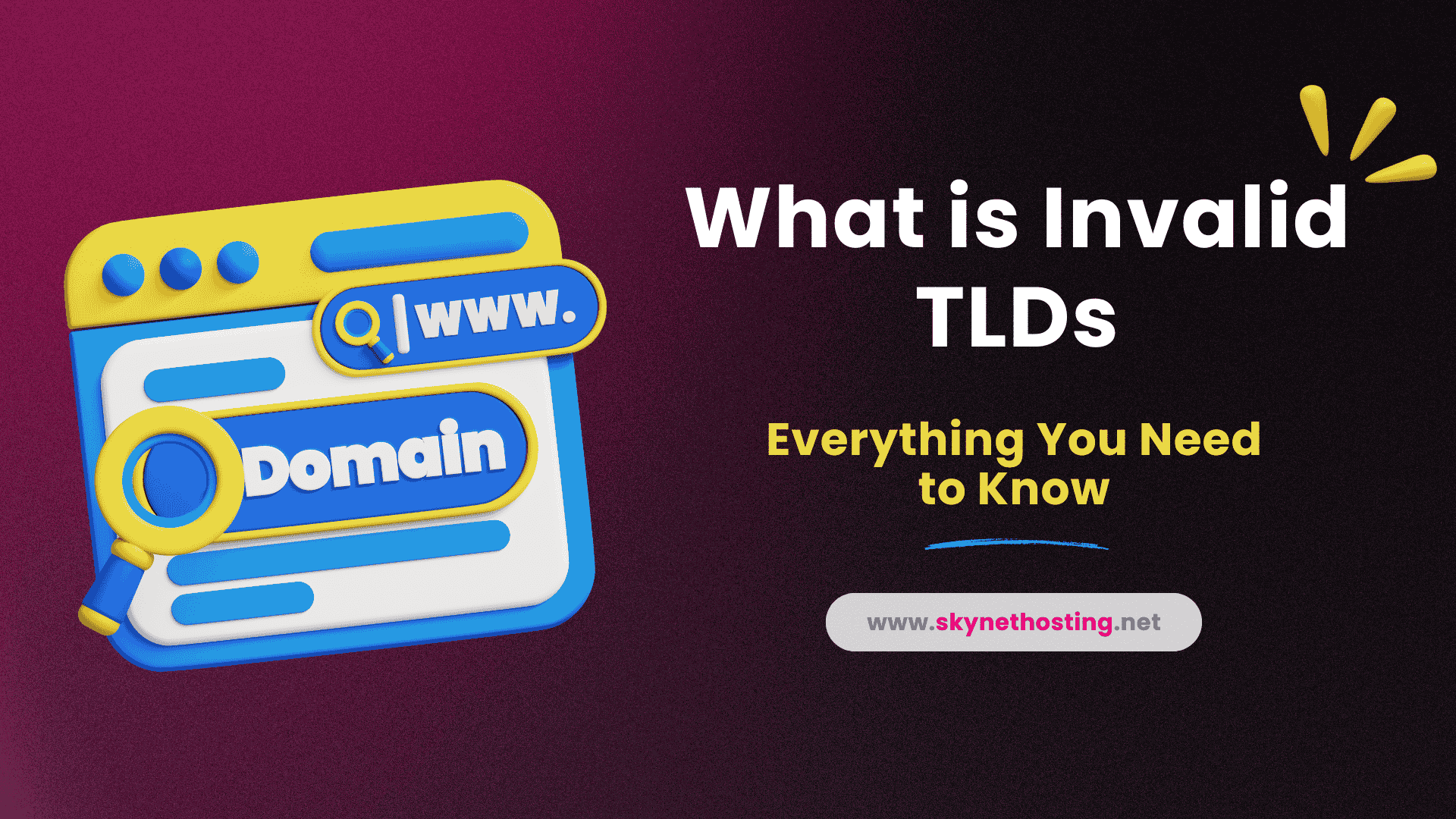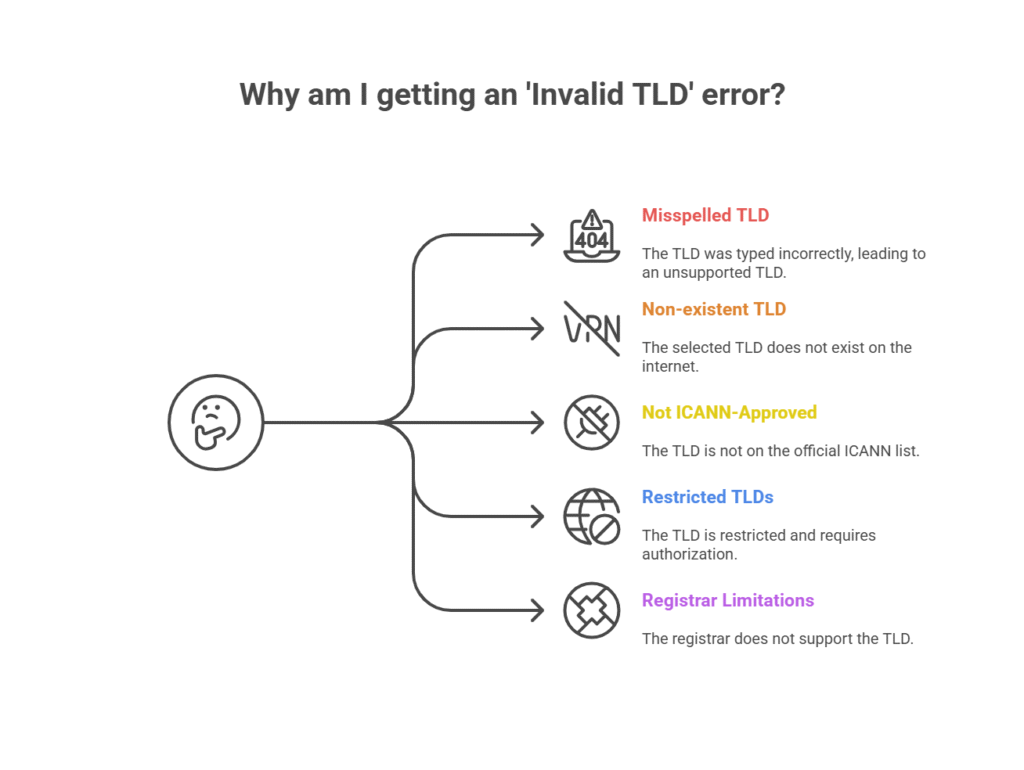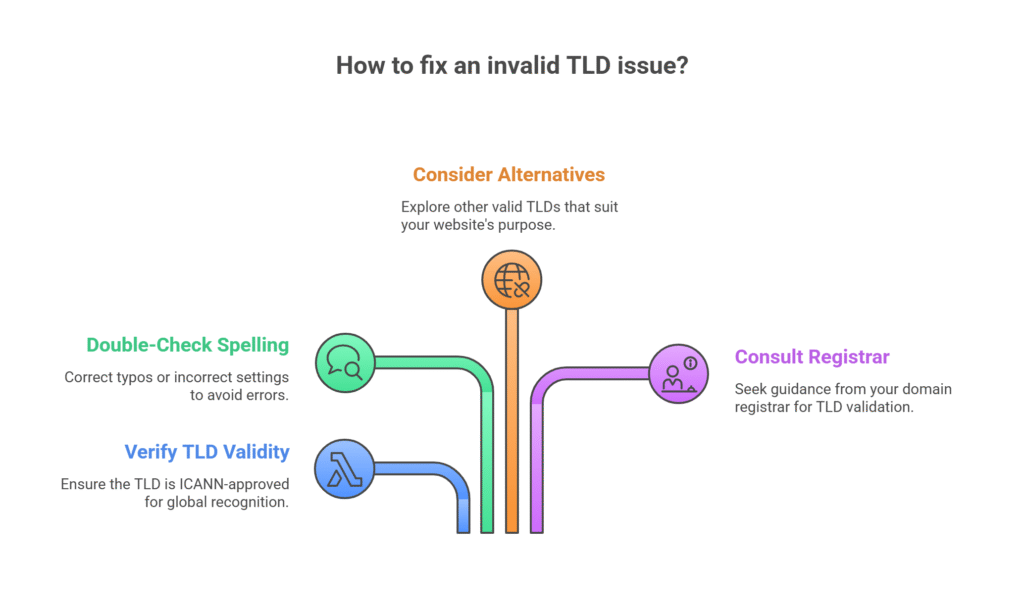
What is Invalid TLDs: Everything You Need to Know
TL;DR
- Understanding TLDs: A Top-Level Domain (TLD) is the final part of a domain name, like .com or .org. It helps organize the internet and is managed by ICANN.
- What “Invalid TLD” Means: This error occurs when your hosting provider or domain registrar doesn’t recognize or support the TLD you are trying to use, preventing successful domain setup.
- Common Causes of Errors: Simple typos, using test domains like “.local,” or choosing TLDs not approved by ICANN are frequent reasons for receiving an invalid TLD error message.
- How to Fix TLD Errors: Start by verifying the TLD is valid and checking for spelling mistakes. If the issue persists, review your DNS settings or contact your hosting provider.
- Choosing a Valid TLD: Stick to globally accepted TLDs like .com, .net, and .org, or country-specific ones. Always confirm your hosting provider supports any new TLDs before purchasing.
- Preventing Future Issues: To avoid problems, research your chosen TLD, use a reputable registrar, and double-check all spelling. Confirming hosting compatibility beforehand is the most effective prevention method.
You’re setting up a domain in cPanel. Everything looks perfect. Then booman “invalid TLD” error appears.
an “invalid TLD” error appears.
I’ve helped hundreds of website owners fix this exact issue over my 10 years in web hosting. It’s frustrating when you can’t figure out why your domain won’t work.
This error typically shows up when you’re trying to add a domain that uses an unsupported or incorrectly formatted top-level domain. But don’t worryan “invalid TLD” error appears.
it’s usually an easy fix once you understand what’s happening.
In this guide, I’ll walk you through everything about invalid TLD errors. You’ll learn what causes them, how to fix them, and how to avoid them completely.
Let’s get your domain working properly.
What Are TLDs (Top-Level Domains)?
Think of a TLD as the last part of your website address. It comes after the final dot in your domain name.
For example, in “google.com”, the “.com” is the TLD.
Understanding how domain extensions work
The domain name system works like a filing cabinet. Each part has a specific purpose:
- Subdomain: www (optional)
- Domain name: google
- TLD: .com
Your browser reads this from right to left. It first looks up the TLD, then the domain name, then any subdomain.
This hierarchical system helps organize the entire internet. Without it, we’d have chaos.
Examples of popular TLDs (.com, .org, .net)
The most common TLDs you’ll encounter are:
Generic TLDs (gTLDs):
- .com (commercial)
- .org (organization)
- .net (network)
- .info (information)
- .edu (education)
Country-specific TLDs (ccTLDs):
- .us (United States)
- .uk (United Kingdom)
- .ca (Canada)
- .de (Germany)
I always recommend .com for business websites. It’s universally recognized and trusted by users worldwide.
Role of ICANN in TLD management
ICANN (Internet Corporation for Assigned Names and Numbers) manages the global domain name system. They decide which TLDs are valid and can be registered.
Every valid TLD must be approved by ICANN. This ensures the internet remains organized and functional.
When you see an “invalid TLD” error, it usually means you’re trying to use a TLD that ICANN hasn’t approved or your hosting provider doesn’t support.
What Does “Invalid TLD” Mean?
An invalid TLD error means your hosting system doesn’t recognize or support the top-level domain you’re trying to use.
This error prevents you from adding the domain to your hosting account or DNS configuration.
Definition and when the error appears
The error typically appears when you:
- Add a new domain to your hosting account
- Configure DNS settings
- Set up email accounts for a domain
- Create subdomains
Your hosting panel recognizes something’s wrong with the domain extension. It blocks the action to prevent configuration issues.
I’ve seen this error most often when clients try to use newer TLDs or make typos in domain names.
Common platforms where you see it (cPanel, WHM, etc.)
You’ll encounter invalid TLD errors in various hosting management systems:
cPanel: When adding addon domains or subdomains
WHM: During account creation or DNS zone setup
Plesk: When configuring new domains
DirectAdmin: During domain addition processes
Each platform has slightly different error messages. But they all mean the same thingan “invalid TLD” error appears.
your TLD isn’t supported or recognized.
Why invalid TLDs can’t be registered or used
Hosting providers maintain lists of supported TLDs. These lists include:
- ICANN-approved generic TLDs
- Country-specific TLDs they support
- New TLDs they’ve added to their systems
If your TLD isn’t on their list, their system rejects it. This prevents technical issues and ensures reliable hosting services.
What Causes Invalid TLD Errors?
Let me share the most common causes I’ve encountered over the years.
Typing errors or unsupported extensions
Simple typos cause many invalid TLD errors. I’ve seen clients type:
- .con instead of .com
- .rog instead of .org
- .nte instead of .net
Sometimes people use extensions that look real but aren’t:
- .local (used for local networks)
- .test (reserved for testing)
- .example (used in documentation)
Always double-check your domain spelling before trying to add it.
Using test or non-ICANN-approved domains
Developers often use test domains during development:
- example.local
- test.dev (before .dev became official)
- mysite.internal
These work fine on local servers. But they fail when you try to use them on live hosting accounts. Some newer TLDs take time to reach all hosting providers. Your domain might be valid, but your host hasn’t updated their systems yet.
Incorrect DNS or zone file entries
Sometimes the error appears due to DNS configuration issues:
- Malformed zone file entries
- Incorrect BIND configuration
- Missing TLD definitions in server settings
These are usually server-side issues your hosting provider needs to fix.
Other common causes of invalid TLD errors

An invalid TLD error most commonly happens during domain name registration when the DNS does not recognize the chosen TLD or when your domain registrar does not support it. Common reasons include:
- Misspelled TLD: Choosing a misspelled TLD, such as typing
.orgas.orgg. This results in an unsupported TLD. - Non-existent TLD: Selecting a TLD that simply does not exist on the internet.
- Not ICANN-Approved: Picking a TLD that is not on the official ICANN-approved list of valid top-level domains.
- Restricted TLDs: Some entities or regions might restrict certain TLDs (e.g.,
.gov,.edu). Attempting to use them without proper authorization will result in an invalid TLD error. - Registrar Limitations: Your domain registrar might not support certain newer or less common valid domain extensions.
Incorrect TLD configuration can also trigger these errors. You should always ensure that the chosen TLD has support from both the DNS and your domain registrar to avoid potential problems and the dreaded “tld not supported” message.
If you are facing invalid TLD errors, working with a reputable Free Domain Reseller can help. They can find valid domain options and make the registration process easier, ensuring a smooth experience.
Common Examples of Invalid TLDs
Many TLDs are simply not supported by DNS due to ICANN restrictions or misspellings. Common invalid TLDs include:
- Typographical Errors:
.example(often used for documentation, not real domains),.coom(a common typo for.com),.nettt(typo for.net). These are classic examples of an unsupported TLD. - Reserved for Testing: TLDs like
.fooor.barmight be used in testing or development environments, but they are not valid for public domains and will result in an invalid domain meaning error if used for live sites. - Restricted TLDs Used Improperly: An invalid domain extension may also occur when a TLD is restricted to specific entities and used without authorization. For instance, the US reserves
.govfor government entities, and.eduserves accredited educational institutions. Attempting to register a domain with such TLDs without proper authorization will result in an invalid TLD error because it becomes an unsupported TLD meaning you lack the credentials to use it.
Understanding these examples can help website owners and digital marketers avoid mistakes, ensuring they choose valid TLDs when registering domains.
How to Fix Invalid TLD Errors

Fixing an invalid TLD issue involves a few straightforward steps. Here’s a step-by-step approach to help resolve the problem:
Step 1: Verify TLD Validity
First, ensure the chosen TLD is part of the official ICANN-approved list of valid top-level domains. This guarantees global DNS recognition and support. Check ICANN’s official TLD list if you’re unsure about a specific extension.
Use Valid ICANN-Approved TLDs
Stick to reliable and well-established TLDs for your domain:
Always Safe Choices:
- .com, .org, .net, .info
- Country codes like .us, .uk, .ca
Newer TLDs Supported by Most Hosts:
- .online, .website, .store
- .tech, .dev, .app
If the TLD you want is restricted or invalid, consider alternative valid domain extensions that suit your website’s purpose and are available for public registration.
Step 2: Double-Check Domain Spelling and Configuration
Typos or incorrect settings can often cause TLD errors. Verify your domain spelling and formatting:
- Check for typos in the domain or TLD (.com, .org, .net, etc.).
- Ensure the domain doesn’t include misplaced spaces or special characters.
- Verify that the domain exists by using a WHOIS lookup tool to confirm it’s registered and active.
Step 3: Verify DNS Configuration in Your Hosting Panel
If the domain spelling and TLD are correct, review your DNS settings:
- Log into your hosting control panel.
- Navigate to the DNS management section.
- Look for any malformed entries or misconfigurations.
- Remove and re-add the domain if necessary, as clearing and recreating DNS entries often resolves issues.
Step 4: Consult Your Domain Registrar
If problems persist, consult your domain registrar to confirm they support the chosen TLD. Reliable registrars like Namecheap.com or SkyNetHosting.net offer a wide range of valid TLDs, making it easier to find a suitable alternative. They can also assist with TLD validation and DNS configuration.
Additionally, partnering with a trusted registrar ensures seamless domain management. For those interested in selling domain names, platforms like SkyNetHosting.net even offer a free domain reseller program.
Step 5: Contact Your Hosting Provider for Technical Support
If all else fails, contact your hosting provider’s support team. They can:
- Verify if your TLD is supported.
- Add the TLD to their system if necessary.
- Address server-side configuration issues.
- Provide alternative solutions to get your domain working.
A good hosting provider updates their TLD support regularly and will guide you through resolving the issue.
By following these steps and working with reliable partners, you can ensure your domain is configured correctly and your website remains accessible.
Valid vs. Invalid TLD: What’s the Difference?
The primary difference between valid TLDs and invalid TLDs lies in their recognition and support by ICANN and DNS.
- Valid TLDs: These are TLDs that ICANN officially approves and DNS widely recognizes globally. They include popular extensions like
.com,.net, and.org, along with newer, industry-specific TLDs such as.techor.shop. These are the valid top-level domains available for legitimate use. - Invalid TLDs: These are TLDs not recognized by DNS or not part of the ICANN-approved list. These might include misspelled TLDs (like a .invalid TLD typo), non-existent extensions, or restricted TLDs used without proper authorization, resulting in an unsupported TLD meaning it cannot be used.

Understanding these differences is crucial for website owners and digital marketers. Choosing valid TLDs ensures seamless DNS resolution and enhances website accessibility and visibility.
How to Know if a TLD is Valid or Not
Verifying the validity of a TLD is essential to avoid potential domain registration errors and ensure you don’t encounter a “tld not supported” issue. Several tools and resources can assist in TLD validation, providing access to the ICANN-approved list of TLDs.
One effective method is to consult the official ICANN website, which regularly updates its list of recognized valid top-level domains.
This ensures that website owners and digital marketers have access to the latest information regarding valid domain extensions. Additionally, many domain registrars offer built-in TLD validation tools.
These tools automatically check the selected TLD against a recognized list and alert users if they choose an invalid TLD.
By using these resources, website owners can confidently choose valid TLDs, making the registration process easier and improving site accessibility.
Which TLDs Are Valid and Supported by Hosting Providers?
Understanding which TLDs work reliably helps prevent future issues.
Popular and globally accepted TLDs
These TLDs work with virtually all hosting providers:
.com – Most trusted for business
.org – Great for organizations and nonprofits
.net – Good for tech companies
.info – Suitable for informational sites
.biz – Business-focused alternative to .com
I recommend these for any serious website project.
Country-specific TLDs (ccTLDs)
Country TLDs are generally well-supported:
- .us (United States)
- .uk (United Kingdom)
- .ca (Canada)
- .au (Australia)
- .de (Germany)
These work great if you’re targeting specific geographic markets.
New generic TLDs (gTLDs) and their usage
Hundreds of new TLDs launched in recent years. Popular ones include:
Tech-focused: .tech, .dev, .app, .io
Business: .store, .shop, .online
Creative: .design, .photography, .art
Support varies by hosting provider. Check with your host before purchasing newer TLDs.
How to Register a Valid TLD and Avoid Errors
Prevention is always better than fixing problems later.
Steps to register a valid domain
Follow this process for smooth domain registration:
- Research your chosen TLD – Verify it’s ICANN-approved
- Check hosting compatibility – Confirm your host supports it
- Use reputable registrars – Stick to well-known companies
- Double-check spelling – Avoid typos during registration
This saves time and prevents headaches later.
Choosing the right TLD for your brand or business
Consider these factors when selecting a TLD:
Brand recognition: .com is still king for credibility
Geographic targeting: Use country TLDs for local businesses
Industry relevance: .tech works well for technology companies
Availability: Your preferred .com might be taken
I usually recommend securing multiple TLD variations if budget allows.
Common mistakes to avoid during registration
Avoid these pitfalls:
- Don’t buy unusual TLDs without checking hosting support
- Don’t assume all registrars support all TLDs
- Don’t forget to renew domains on time
- Don’t use trademark-infringing names
Always verify hosting compatibility before purchasing any domain.
Why Choose Skynethosting.net for Domain and Hosting Services
After 20 years in the hosting industry, I’ve seen what makes providers reliable.
Domain registration with 400+ supported TLDs
Skynethosting.net supports over 400 TLD extensions. This includes:
- All popular generic TLDs
- Most country-specific TLDs
- Many newer gTLD options
- Regular updates for new extensions
You won’t hit invalid TLD errors with their comprehensive support.
Free DNS management and setup help
Their technical team provides:
- Free DNS configuration assistance
- 24/7 support for domain issues
- Help with complex DNS setups
- Migration assistance from other providers
This eliminates technical headaches for website owners.
24/7 support for domain and hosting issues
When problems arise, you need reliable support. Skynethosting.net offers:
- Round-the-clock technical assistance
- Expert knowledge of domain systems
- Quick resolution of TLD-related issues
- Friendly, helpful customer service
Their team understands both domains and hosting inside and out.
Understanding Valid TLDs Ensures Reliable Performance
Invalid TLD errors don’t have to derail your website projects.
By understanding how TLDs work and choosing supported extensions, you’ll avoid most issues. When problems do occur, the fixes are usually straightforward.
Remember these key points:
- Always verify TLD spelling and format
- Stick to well-established extensions for important projects
- Check hosting provider compatibility before buying domains
- Contact support when you encounter persistent issues
Skynethosting.net simplifies domain setup and management
With comprehensive TLD support and expert technical assistance, Skynethosting.net eliminates common domain headaches.
Their 20 years of experience means they understand the challenges website owners face. Whether you’re launching your first site or managing multiple domains, their team ensures smooth operations.
Ready to avoid invalid TLD errors completely? Consider switching to a hosting provider that supports the domains you need.
Your website deserves reliable hosting that just works.
FAQs
What does ‘invalid TLD’ mean?
An invalid TLD is a Top-Level Domain that the Domain Name System (DNS) does not recognize or support. This can happen because of misspellings (e.g., a .invalid TLD like .coom), nonexistence, or lack of ICANN approval, leading to an invalid domain meaning it cannot be used.
Why do I get an ‘invalid TLD’ error?
Invalid TLD errors usually happen during domain registration when DNS does not recognize the chosen TLD or when the domain registrar does not support it. This often means the tld not supported by the system you’re using.
How can I fix an invalid TLD issue?
To fix an invalid TLD issue, first check the TLD against the ICANN-approved list of valid top-level domains. Then, meticulously look for any typos. Finally, talk to your domain registrar for help or to confirm they support your chosen valid domain extension.
What is the difference between a valid and invalid TLD?
Valid TLDs are officially recognized and supported by ICANN and DNS, ensuring global accessibility. Invalid TLDs are not recognized, often due to misspellings, non-existence, or restrictions, meaning they are an unsupported TLD.
What are some examples of invalid TLDs?
Common invalid TLDs include misspelled extensions like .comm or .nettt, non-existent ones used in testing environments such as .foo or .bar, or restricted TLDs (like .gov or .edu) used without proper authorization.
How do I know if a TLD is valid or not?
To verify the validity of a TLD, consult the official ICANN list of valid top-level domains or use domain registrar validation tools. These resources provide up-to-date information on recognized and valid domain extensions, helping you avoid a “tld not supported” message.
What does TLD mean in the context of domain names?
TLD stands for Top-Level Domain, which is the last segment of a domain name after the final dot (e.g., .com, .org, .net). Understanding what does TLD mean is fundamental to grasping domain name structure.
Why is it important to choose a valid TLD?
Choosing a valid TLD is critical for your website’s online presence. It ensures your site is accessible to users, recognized by search engines, and builds credibility. Using an invalid TLD or an unsupported TLD will lead to your website being unreachable.



